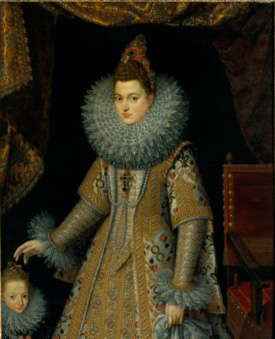DISCUSS
Unknown (North India, Mughal)
Portrait of the Emperor Shah Jahan in Old Age, late 17th century
In this portrait, the Emperor Shah Jahan is shown standing in a pose against a nebulous background.
- How would you describe this pose?
- What do you think the pose communicates about the Emperor?
- What other details do you notice about the figure?
Famous as the Mughal emperor who ordered the construction of the Taj Mahal, the Emperor Shah Jahan favored an artistic style that emphasized royal and iconic authority in imperial portraiture. This small and detailed painting was designed for close, intimate viewing, perhaps in an album or book format.
Now compare this portrait of the Emperor with another portrait of royalty from WCMA’s collection (show below):

Frans Pourbus the Younger (Flemish, 1569–1622)
Portrait of Infanta Isabella Clara Eugenia, 1599–1600
oil on canvas
51 x 41 5/8 in.
Gift of Prentis Cobb Hale, Jr.
64.31
Infanta Isabella Clara Eugenia, daughter of King Phillip II of Spain, and her husband Albert the Archduke of Austria ruled the Netherlands on behalf of Spain in the early 17th century.
Compare her portrait with Shah Jahan's. What similarities do you see? What differences?
Some points of comparison to consider:
- What size are these paintings?
- What type of paint did each artist use? How does the effect of watercolor compare with the effect of oil paint?
- What are the royal figures wearing?
- How are the royal figures posed?
- How would you describe the background?
- In what direction are the figures looking? What is their relationship to the viewer?
- What does each portrait say about its subject and their qualities as rulers?
- Do these rulers seem powerful? Inspiring? Generous? Strict? Why or why not?
- What details indicate their royal status?
Shah Jahan's portrait was meant to be seen up close in an album, while the portrait of the Infanta was probably hung in a large royal court building where many could have viewed it from afar. Do you think these considerations influenced the artists? How so?